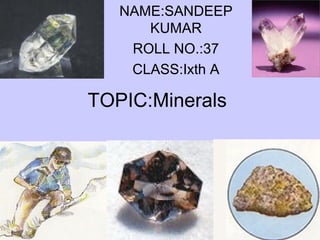Minerals
- 1. NAME:SANDEEP KUMAR ROLL NO.:37 CLASS:Ixth A TOPIC:Minerals
- 2. Native Elements Only a few minerals occur as pure elements in the earthâs crust. Gold Graphite Silver Sulfur Diamond Copper Platinum Au C Ag S C Cu Pt
- 3. Most are found as chemical compounds called minerals Beryl Be Al Silicate Quartz SiO2 Calcite CaCO3
- 4. Rocks are mixtures of minerals and elements. Lapis lazuli Unakite âĒ Lazulite Boulder Opal quartz,feldspar âĒ Calcite opal in cracks epidote âĒ Pyrites of boulder
- 5. CHEMISTRY âĒ An element contains only one type of atom âĒ A compound contains two or more elements chemically combined âĒ A mixture contains elements and or compounds that are not chemically combined GEOLOGY âĒ A Native Element contains only one type of atom and is found naturally on earth in its pure form. âĒ A mineral contains two or more elements chemically combined âĒ A rock contains a mixture of elements and compounds
- 6. ORES are rocks containing valuable minerals âĒ Hematite Malachite Galena Iron Ore Copper Lead Gold in Quartz
- 7. ORES âĒ Gold in W.A. is mined from tellurides, chlorites, quartz veins and in copper ores at Telfer âĒ Gold nuggets are native elements. âĒ Copper is found in cuprite, malachite and azurite âĒ Native copper is rare âĒ Iron ores consist of haemetite, magnetite, pyrite and limonite âĒ Diamond in W.A. is mined from volcanic plugs called Kimberlite pipes. Crystalline Haemetite is used to make jewellery
- 8. ORES
- 9. âĒ Only a few minerals are rock forming and most rock is made from a combination of the commonest of these such as feldspars, quartz, mica, olivine, calcite, pyroxene and amphiboles
- 10. Physical Properties of Minerals âĒ COLOUR âĒ HARDNESS âĒ CLEAVAGE âĒ SPECIFIC GRAVITY âĒ STREAK âĒ CRYSTAL FACES
- 11. Colour...................... Most minerals are coloured by a limited number of metals present as impurities. The most common elements affecting colour are: chromium, iron, manganese, titanium Minerals tend to occur in a range of colours, and colour patterns which help to identify them It is chromium which produces and copper. the intense red of ruby and the brilliant green of emerald.
- 12. Quartz displays a profusion of colours, patterns and optical effects unsurpassed by any other gem colourless is rock crystal purple quartz is amethyst yellow is citrine brown is smoky quartz pink is rose quartz. black is morion
- 13. Hardness................... - âĒ Hardness depends upon the forces holding the atoms of the mineral together. âĒ In 1812, a scientist, F. Moh devised a scale of hardness into which all minerals can be placed. âĒ He selected ten minerals and arranged them in order so that any one mineral could be used to scratch only minerals which are less. âĒ Diamond is the- hardest natural material, 140 times harder than corundum.
- 14. Cleavage................ Distinct cleavage planes can be illustrated in this box mica specimen The manner in which a mineral splits is an aid to identification. These planes are related to the lattice work of the mineral's atomic structure.
- 15. StreakâĶâĶâĶâĶ âĒ When minerals are scratched, the powder that is made by the scratch is called the streak. âĒ Sometimes the colour of the streak can be used to identify the mineral. âĒ Eg. Haemetite a black mineral has a red streak. No other black mineral has a red streak.
- 16. Specific Gravity................... âĒ It was Archimedes who first worked out the principal of specific gravity or relative density. Specific gravity is defined as the ratio of the weight of a substance compared to that of an equal volume of water. âĒ For example, a piece of galena (lead ore), with a specific gravity of 7.4 will feel much heavier than a piece of quartz of a similar size but with specific gravity of 2.65, reflecting the way the atoms are packed together.
- 17. Crystals Crystals are minerals or elements that have been cooled slowly enough for crystals to have formed. Such conditions occur most often in pegmatites or pipes. Crystals can be classified by their shapes into seven groups.
- 18. Next slides are advanced or extension only âĶâĶ.
- 19. Optical effectsâĶâĶâĶ. In diamond the 'fire' and sparkle is caused by dispersion as the gemstone acts like a prism. The brilliant colours displayed by opal are caused by the light being scattered as it passes through planes of regularly spaced voids between the transparent silica spheres.
- 20. Double Refraction âĶâĶâĶ. Double refraction can be seen in a piece of Calcite. Light separates into two rays which makes images seen through the crystal appear to be doubled.
- 21. Refraction.................... âĒ This is a measure of the mineral's ability to bend a beam of light. This ability is called refractive index. Ruby coloured by chromium Some gemstones can be identified by the spectral colours they produce. Almandine garnet coloured by iron -Measuring refraction using an optical instrument called a Refractometer.
- 22. What makes a mineral a Gemstone? âĒ There are over two hundred recognised gemstones. Most are minerals and are cut from naturally occurring crystals. âĒ To qualify as a gem, the specimen should be hard and tough to resist scratching and have beautiful clarity, colour or 'fire'. Value is based on rarity and rare quality.





















